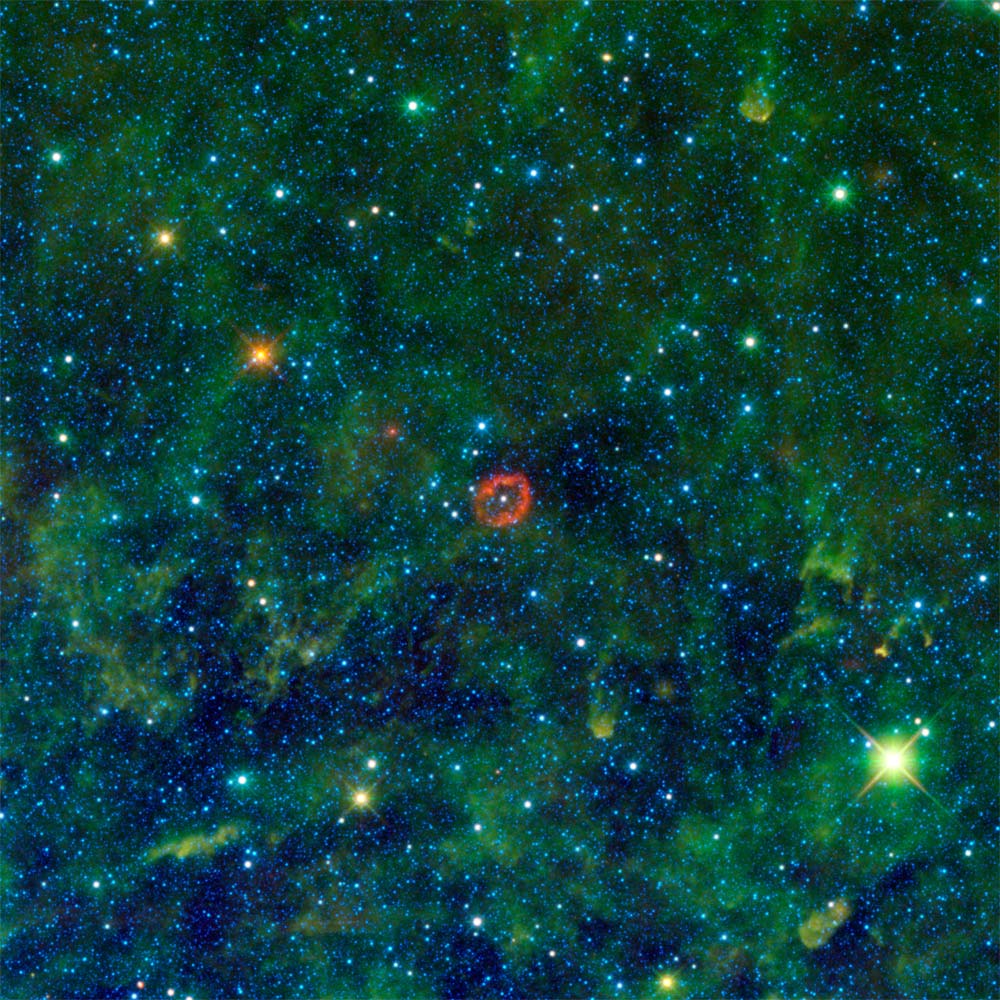Puffy Star Looks Like Cosmic Jellyfish

A new photo a star shedding its gassy layers bears astriking resemblance to a red jellyfish floating in a sea of green kelp.
The jellyfish-star photo depicts a sphere of stellarinnards, blown out from a humongous star as it ages. The star (white dot incenter of red ring) is one of the most massive stellar residents of our MilkyWay galaxy.
The new image was taken by NASA's Wide-field Infrared SurveyExplorer (WISE), currently in orbit around Earth. [MoreWISE telescope photos.]
Called V385 Carinae, the star spotted by WISE is 35 times asmassive as our sun, with a diameter nearly 18 times as large. It's hotter, too,and shines with more than one million times the amount of light.
Objects like this are called Wolf-Rayetstars, after the astronomers who found the first few, and make our sun lookpuny by comparison. These fiery candles burn out quickly, leading short livesof only a few million years (our sun is middle-aged and about 4.6 billion yearsold).
As they age, Wolf-Rayet stars blow out more and more of theheavier atoms cooking inside them ? atoms such as oxygen that are needed forlife as we know it.
The material is puffed out into clouds like the one thatglows brightly in the new image. In this case, the hollow sphere showed upprominently only at the longest of four infrared wavelengths detected by WISE.
Get the Space.com Newsletter
Breaking space news, the latest updates on rocket launches, skywatching events and more!
Astronomers think this infrared light comes from oxygenatoms that have been stripped of some of their electrons by ultravioletradiation from the star. When the electrons join up again with the oxygenatoms, light is produced that WISE can detect with its 22-micron infrared lightdetector.
The process is similar to what happens in fluorescent lightbulbs.
Infrared light in one wavelength is colored green, whilelight in another range is blue. The green, kelp-looking material is warm dust,and the blue dots are stars in our MilkyWay galaxy.
This image mosaic is made up of about 300 overlappingframes, taken as WISE continues its survey of the entire sky.
V385 Carinae is located in the Carina constellation, about16,000 light-years from Earth.
- WISE Up: Space Telescope's Stunning First Photos
- Images: An Infrared View of the Cosmos
- Top 10 Star Mysteries
Join our Space Forums to keep talking space on the latest missions, night sky and more! And if you have a news tip, correction or comment, let us know at: community@space.com.

Space.com is the premier source of space exploration, innovation and astronomy news, chronicling (and celebrating) humanity's ongoing expansion across the final frontier. Originally founded in 1999, Space.com is, and always has been, the passion of writers and editors who are space fans and also trained journalists. Our current news team consists of Editor-in-Chief Tariq Malik; Editor Hanneke Weitering, Senior Space Writer Mike Wall; Senior Writer Meghan Bartels; Senior Writer Chelsea Gohd, Senior Writer Tereza Pultarova and Staff Writer Alexander Cox, focusing on e-commerce. Senior Producer Steve Spaleta oversees our space videos, with Diana Whitcroft as our Social Media Editor.











